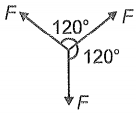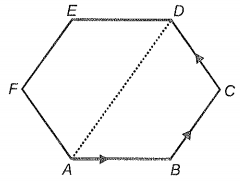When a force of magnitude F acts on a body of mass m the acceleration produced in the body is a. If three coplanar forces of equal magnitude F act on the same body as shown in the figure, then acceleration produced is

1. 0
2.
3.
4.

Three forces each of magnitude 1 N act along with the sides AB, BC, and CD of a regular hexagon. The magnitude of their resultant is:

(1) 4N
(2) Zero
(3) 2 N
(4) 1 N
If a unit vector \(\hat j\) is rotated through an angle of \(45^{\circ}\) anticlockwise, then the new vector will be:
1. \(\sqrt{2}\hat i + \sqrt{2}\hat j\)
2. \(\hat i + \hat j\)
3. \(\frac{1}{\sqrt{2}}\hat i + \frac{1}{\sqrt{2}}\hat j\)
4. \(-\frac{1}{\sqrt{2}}\hat i + \frac{1}{\sqrt{2}}\hat j\)
\(\overrightarrow A\) and \(\overrightarrow {B}\) are two vectors given by \(\overrightarrow {A}= 2\hat i + 3\hat j\) and \(\overrightarrow {B}= \hat i + \hat j\). The component of \(\overrightarrow A\) parallel to \(\overrightarrow B\) is:
1. \(\frac{(2\hat i -\hat j)}{2}\)
2. \(\frac{5}{2}(\hat i - \hat j)\)
3. \(\frac{5}{2}(\hat i + \hat j)\)
4. \(\frac{(3\hat i -2\hat j)}{2}\)
If a vector is inclined at angles \(\alpha ,\beta ,~\text{and}~\gamma\), with \(x\), \(y\), and \(z\)-axis respectively, then the value of \(\sin^{2}\alpha+\sin^{2}\beta+ \sin^{2}\gamma\)
is equal to:
1. \(0\)
2. \(1\)
3. \(2\)
4. \(\frac{1}{2}\)
If is the unit vector in the direction , then:
1.
2.
3.
4.
Which of the following sets of forces cannot give zero resultant?
(1) 3 N, 4 N, 5 N
(2) 9 N, 8 N, 7 N
(3) 16 N, 2 N, 17 N
(4) 30 N, 5 N, 24 N
If two force vectors of the same magnitude are arranged in the following manner, the magnitude of resultant is maximum for?

(1) (I)
(2) (II)
(3) Both (II) & (III)
(4) Both (I) & (II)
The minimum number of non-coplanar vectors whose vector sum can be zero is:
(1) 2
(2) 3
(3) 4
(4) 5






